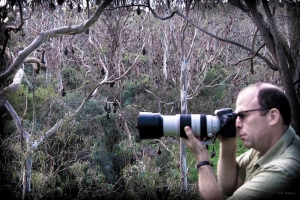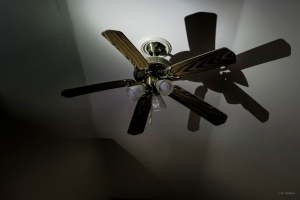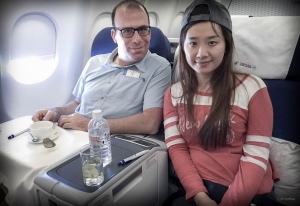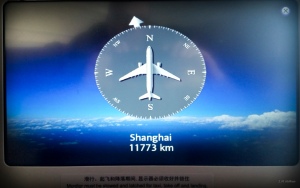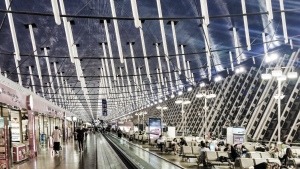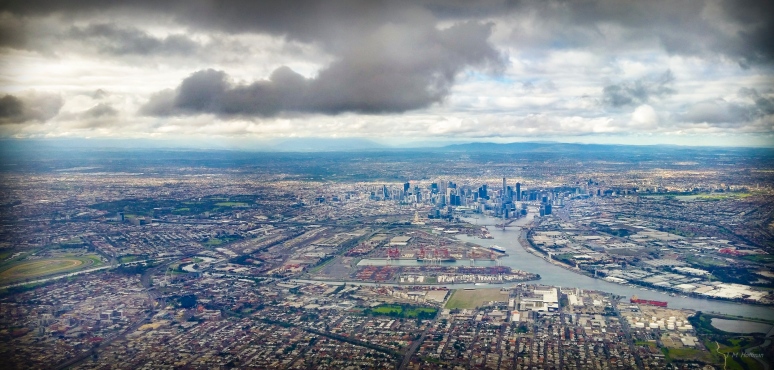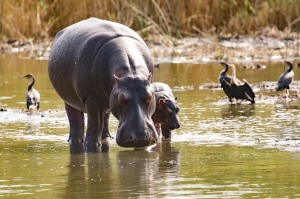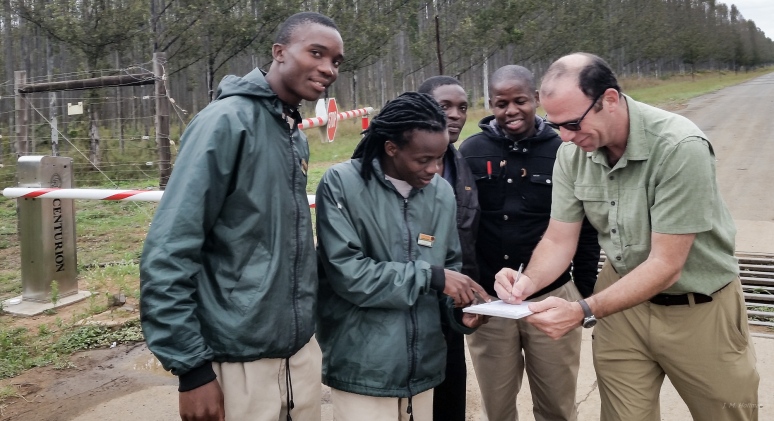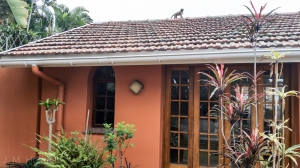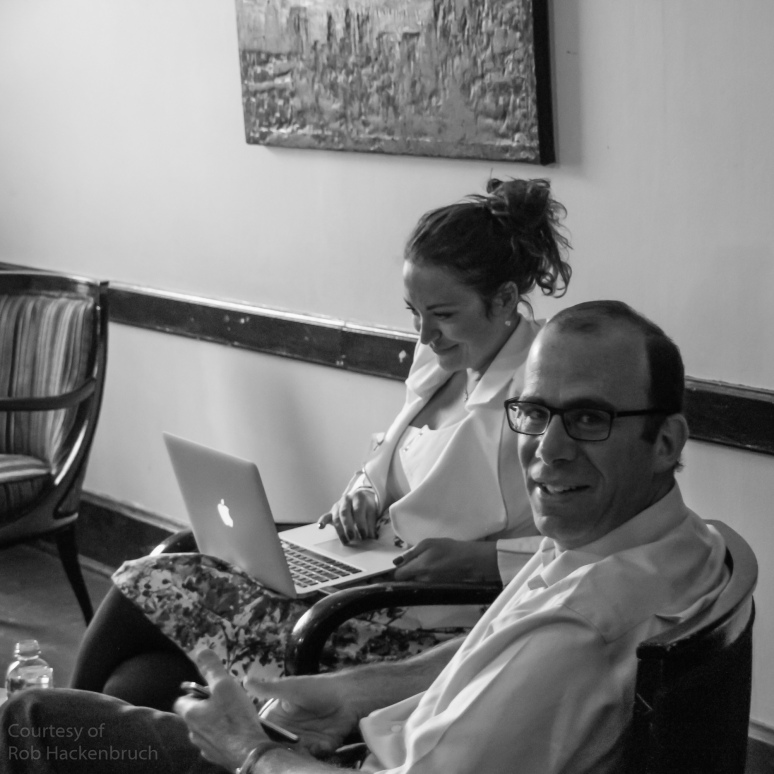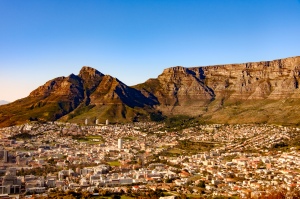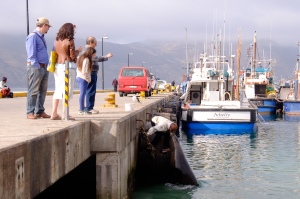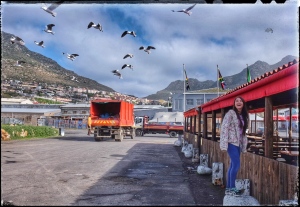Australia: Melbourne (Day 2 in Country)
After an exhausting journey and then a failed outing to see penguins, I slept well and awoke on Friday eager to see Melbourne.
My day started with a wonderful breakfast with friends at Batch Espresso, just one of many cafes and restaurants on the trendy Carlisle St. that was a short walk from my hotel.
Well fed, I headed for Melbourne proper by tram, arbitrarily getting off at Flinders Street Station. (I would later learn that Melbourne has the world’s largest urban tram network.) I walked around for a while, found lunch in an alley chock full of dining options, explored the trains (I like trains), and, when it started raining, took an adorable old tourist tram around the city. From what I saw, Melbourne looked much like any other former British colony, but it was also uniquely Australian in a way that would take me a while to pin down.
At one point I got to thinking. I had group dinner plans in St. Kilda that evening. The penguins that I had yet to see were supposed to arrive at St. Kilda pier (also in St. Kilda) around dusk. Could I squeeze in another attempt to see them? Yes, but barely. I headed back out of town on a tram that would take me right to the pier.
I arrived before dusk. It was pretty cold — colder, I would later be told, than anyone ever remembered in June — but at least it wasn’t raining. So I walked out onto the pier. And there, in broad daylight, right before my eyes, waiting to welcome me to the Southern Hemisphere was a penguin!
I snapped a shot of the bird, then turned in the other direction, where I saw the Melbourne skyline put into almost surreal context by a neighboring marina.
I headed off to dinner content.
This slideshow requires JavaScript.
Australia: The Search For Penguins (Day 1 in Country)
I was pretty tired after traveling for three days to get to Melbourne, so some details of my arrival are pretty fuzzy. In fact, I know I was at the airport, because that’s where planes land, but I have no actual memory of it.
I do remember checking into our hotel — in the suburb of St. Kilda — in mid-afternoon.
And I remember making plans immediately thereafter to find penguins, which, I had heard, returned to their home on the St. Kilda pier after dusk. Sunset that day was around 5:45pm, and the pier was about an hour’s walk from my hotel. So at 4:30, camera in hand, I set out on that dreary afternoon.
My Telstra pre-paid cell service wasn’t working yet (it turned out they had forgotten to activate it in the store where I purchased the SIM), so I had an electronic map, but no walking directions. Still, I found my way on foot, trying to remember as I crossed each street to look right for oncoming traffic.
My timing was perfect. I got to the water at 5:30, with a few minutes before dusk during which I could grab a snack.
Then as I was preparing to walk out onto the pier to see the penguins, the clouds opened up and rain attacked the beach with a vigor that lowered visibility to almost nothing. I couldn’t even see the pier. Walking out along it into the ocean to see penguins was out of the question.
I waited about an hour, hoping the rain would pass, but it didn’t. I gave up on the penguins and started to plan a journey back to the hotel. Fortunately, I had thought to bring an umbrella with me, but unfortunately the wind meant that it was of limited use. So I didn’t really want to walk an hour back. A taxi, maybe? Public transportation? In my jetlagged state I decided that wandering around at random would be my best bet, because I could probably find a taxi that way. Astoundingly, that worked.
Soaked, I got back to the hotel, had an edible if overpriced dinner there, and went to sleep at 9:00pm.
So I have no pictures of penguins to show you from that day. But stay tuned. I wasn’t giving up so easily!
The Case of the Bat in the House
I wish it were fiction.
When I awoke around 3:30am on Thursday, I was thirsty, and I also had a vague sense that something was wrong — probably just a bad dream, I mistakenly thought.
Rising, I made my way out of the bedroom, through the hall, and toward the living room and kitchen. As usual, I didn’t bother with my eyeglasses, and I left the lights off, so I had only a dim, blurry notion of my surroundings when I became aware of rapid and erratic movement in the dark.
Time slowed.
Must be a moth, I thought at first. The realization startled me, thanks to my childhood phobia of small flying things. As I was reminding myself that moths are harmless, another part of my brain recognized the flight pattern my eyes had seen and sent a more urgent message: There’s a bat in the house!
I did what any rational person would do under the circumstances: I ran in terror back to my bedroom and slammed the door.
My heart pounding and my mouth still dry from thirst, I was unable to fall back asleep.
Somewhere around 4:30am, prodded by an on-line video from the county I probably shouldn’t have watched, I decided that the prudent thing to do was to go back out of my room, find the bat, watch it land, trap it, and send it to a local lab to be tested for rabies.
I steeled myself and ventured out. I equipped myself with a plastic lid and a solid piece of cardboard, the tools I would need to trap the bat. I donned a pair of latex gloves. And I walked around the house, turning on lights as I went. But the bat was gone.
Around 5:00am, I gave up and went back to bed. I fell asleep and dreamt about bats and rabies.
Knowing that the bat had almost certainly been in my room while I slept, and knowing that bat bites can be undetectable, and knowing that unchecked rabies is lethal, I heeded the recommendations of my local health department and arranged for prophylactic treatment, which meant a trip to the emergency room where I got five shots.
Sore and exhausted, I bumbled through the rest of the day.
What of the bat?, you might be wondering. Surely, I thought, it had left the way it had entered. After all, bats are clever creatures. It could find its way out. Certainly I hadn’t seen it after that one time in the blurry dark.
By 9:00pm, I was exhausted, but it was too early for sleep, so, as I sometimes do, I lay down atop my still-made bed for a movie.
My attention drifted as I watched, and I started to wonder if it really was a bat that I had seen the night before. Maybe my mind was just playing tricks on me. After all, the previous day I had been editing images from the flying-fox bat colony I had photographed in Australia. Perhaps I just had bats on the mind, and perhaps my combined mental and visual haze that night had led me astray. I never did get a good look at the bat. Perhaps it had just been a moth. Well, whatever. The day was over and I was tired. I let the movie play.
About an hour later, the bat darted into my room, its wings extending nearly a foot, its shifting shape circling rapidly mere feet above me, round and round, sometimes lower, sometimes higher, menacing, like an aerial show of power from a lethal helicopter in wartime clamping down hard on a population. I froze.
I tried to remind myself the bat couldn’t actually hurt me, but it turns out that that kind of information is easier to process in the abstract.
When the bat finally flew off, I again slammed the door shut. But this time I knew I had to go back out. I had to find the bat. If it hadn’t left my house the previous night, it wouldn’t leave now. Armed with a mantra of “it can’t hurt me,” I again equipped myself with the gloves and the plastic and the cardboard, and set out to capture the bat.
It can’t hurt me.
I opened the bedroom door.
It can’t hurt me.
I walked out into the hall.
It can’t hurt me.
I walked down the hall toward the living room.
It can’t hurt me.
The bat, whipping around the living room, turned toward me and charged. I retreated in panic back to my bedroom.
So there I was, barricaded in my bedroom, not actually shaking but certainly surprised at my inability to stay calm. I was so rattled — I realized only the next day — that I didn’t even think to photograph the bat. Instead, I thought maybe I should just move.
I went online and found a 24/7 emergency pest-control service. I felt like an idiot, because a harmless animal can hardly be considered an emergency, and, besides, certainly I could handle the bat myself. But I called nonetheless. No one answered. I tired another service, TriState Wildlife, and this time I reached an easy-going and reassuring dispatcher. His first suggestion was that I could just open all the doors and windows in the house to let the bat out. I explained that, because of where I live, that was much more likely to let more bats in. So he told me that someone could come by my house in about 45 minutes. “Just hang out in the bedroom and relax until my guy arrives,” he said. Sure.
Around 11:30pm, a car drove up to my house. Exiting my self-imposed prison, I greeted a cheerful and friendly guy who had come to help. I also discovered that the bat was, thankfully, no longer bolting through the air. But that meant that we had to find it. We worked our way through the house, looking above cabinets and under tables, checking the bathroom towels and the living-room sofa cushions, examining the thousands of books in my home office, peering into corners and dark crevices. (He did more peering than I did.)
But for the animal’s second appearance, I would certainly have thought at this point that I had imagined the whole thing. But no. I knew there was a bat.
Maybe on the ceiling fan suspending 12 feet high in my home office? The guy told me to turn on the fan to check. No bat. I asked if it could be inside my piano. Sure. It could be inside a ventilation duct, too, he offered, and when that happens the only thing to do is wait.
Maybe 10 minutes later he finally spotted it. It was asleep at the base of the ceiling fan, some 13 feet in the air. We had stared right at it and not seen it. In spite of its 11-inch wingspan, the bat is pretty small, and can be very hard to notice. (Can you see it in the photo to the left? Here’s a detail.)
I was also grateful in a way, because the bat’s location validated my decision to call a professional. I probably wouldn’t even have seen the bat on my own. And there’s no way I could have got it down by myself. I do own a ladder, but there’s a pretty good chance that if I had climbed up to get the bat, I would have fallen off when instinct overcame rationality.
The professional suggested that maybe I wanted to take a photo or two before he removed the bat. Of course I did. That I hadn’t thought to do so before shows my state of mind. (Incidentally, I wish all of my business encounters were as positive as my experience with TriState.)
And there it is. Fortunately, my visitor is gone now. The only thing is, there’s obviously a way for another one to get in.
Australia: Days 1, 2, and 3 (Getting There)
I used to think that Alaska was far away. Then I thought that South Africa was distant. But Australia, wow! Melbourne is so remote that there are no direct flights from New York. You have to transfer somewhere.
This is how I came to hold a ticket on China Eastern Airlines for Shanghai, from where I could catch a continuing flight to Melbourne. Mercifully, I was able to upgrade to business class on both legs.
My journey began with the usual drive to JFK airport — always an adventure in itself — this time to Terminal 1. I arrived early, and sped through check-in, security, and customs. Then I spent a bit of time in the Air France lounge, which, while not as nice as Delta’s flagship lounge in Terminal 4, got the job done.
Boarding was delayed, for reasons no one made clear, but not by much.
So we took off roughly on time, and I settled in to my reasonably comfortable lie-flat seat to sleep as much as possible, even though it was only 5:00pm in New York, too early for sleep, and it was already 7:00am the next morning in Australia, time to wake up.
I live a place called the West, and I was heading for the Far East. So once we’d left the congested New York airspace the pilot pointed the plane due north and flew straight for fifteen hours. It turns out the earth really is round.
The language barrier on the flight made things a bit uncomfortable for me. I’m used to being able to communicate, at least a little, in whatever environment I find myself. But I don’t speak Chinese, and while most of the flight attendants knew a few words of English, actual conversation was all but impossible. This might explain why, toward the end of the flight, I ended up with garlic bread for breakfast. Or it might not. I don’t know.
The only major problem with the flight was the plane itself, a modern Boeing 777 which, astonishingly, did not offer personal air vents. So I spent fifteen hours wishing it were cooler.
Even when we landed in Shanghai after fifteen hours, though, I was still ten hours from my destination of Melbourne, or roughly the distance from New York to Tel Aviv. Apparently the earth is not just round, but huge.
Fortunately, I had a few hours in the Shanghai airport. Unfortunately, the place is underwhelming. Now, if people judged New York City on the basis of Kennedy Airport (which I and others after me have called an island of the third world conveniently located in the heart of the first), tourism in the Big Apple would die overnight. So I’m not judging. But air conditioning would have been nice. At least in the frequent-flyer lounges. (On paper, one of the perks of the lounges, along with beverages and food, is air conditioning. In practice, the “air conditioning” is one small unit in one corner of one room of a club that isn’t walled off from the main airport.)
I actually had my choice of a few clubs, thanks to various frequent-flyer and credit-card perks, but they were all about the same: a bit of food, some drinks, a few seats, and not much more. They did offer WiFi, which was nice. Some of the clubs blocked Western sites likes Facebook and Google more completely than others. Some offered departure signs in both English and Chinese. One of the clubs sported a shower, which I took advantage of.
None of the food was good. Again, to be fair, there was also a major language barrier: Most people spoke no English or only a few words, and while both Chinese and English writing labeled the food, the English words ranged from odd to incoherent. Additionally, I’m both a vegetarian and a picky eater, so I don’t just sample whatever happens to be before me. For all I know, for instance, the snack marked “for the edible” would have been tasty. But I had no idea what it was.
I did wonder if the other food was perhaps not for the edible.
When I left the club at one point to explore, I spotted someone carrying a Starbucks coffee cup. Encouraged, I kept walking until I found food and drink that I could positively identify. And as befits a company like Starbucks, the salespeople spoke at least broken English.
Boarding my next flight — a mere ten-hour hop to Melbourne — was chaotic, and the heat and humidity at the departure gate were oppressive. But once on board I lucked out. Sitting next to me was a delightful traveling companion who, though Chinese, spoke wonderful English. So when we weren’t sleeping, we chatted about China, her life there, my life in America, and our common destination of Australia. She also served as my translator during the flight.
We landed in Melbourne shortly after noon on Thursday. (I had left on Tuesday afternoon. I didn’t get a Wednesday that week.) My new companion and I navigated the arrival process together and agreed to stay in touch as we explored this new country.
I don’t remember feeling unduly tired when we landed, and I had actually slept for the better part of both flights, but, equally, I don’t remember much from the airport in Melbourne. I know I was met by someone, and I remember something about wind. But that’s it.
I also know that over 700 words into this essay I still haven’t written anything about Melbourne. That’s what Australia is like for New Yorkers. It takes a long time just to get started.
South Africa: A Brief Side Story
I was on my way back to the Durban airport to start my three-flight journey home to New York, via Johannesburg and London. The gift was for a fellow traveler, and when I had bought it I had supposed I would put it in the mail once I returned to New York. But now a better idea presented itself, because the recipient was staying in Durban for an extra day.
I asked my driver if there was any possibility he could drive by a hotel in downtown Durban after he dropped me off at the airport. He graciously assured me that it wouldn’t be a problem. I was already late for my flight — having cut the timing very close in order to enjoy the most out of a boat ride on the Lake St. Lucia Estuary — but once at the airport I scribbled a quick note and handed it to my driver.
Then I ran into the airport, waited in line, paid a small fee for my overweight luggage (which involved waiting in another line), and boarded my flight.
In the Johannesburg airport, I made my way to the (relatively) luxurious Virgin Airways business lounge, where I ordered dinner. As my food arrived, my phone rang. My gift had been successfully delivered.
“Did you leave me something at the hotel,” I was asked.
“Yes,” I said.
“But aren’t you in Johannesburg?”
“Yes.”
“So how—”
“I had my driver do it,” I explained.
Amazing, I then thought, how easily such a sentence came to my lips.
South Africa: The Second Safari — Part 2
So off we went. After a delicious breakfast, we drove through the African bush to the waterfront, and from there set out.
There’s a relaxing magic to the water. Even without any animals, the ride would have been spectacular. But we did see animals: hippos, of course, all over the place (I’d already seen a few the previous night); abundant bird life, including the Goliath Heron and African Lake Eagle; and even a lizard of some variety, cunningly disguising itself as a branch.
Once again, the photos tell the story, so here they are. Click on any thumbnail for a larger view:

South Africa: The Second Safari
I was excited for Tuesday morning and its promise of a return to nature. My destination was a unique mix of ecosystems that hosts exotic animals both on land and in the water, thanks to Lake St. Lucia. Called iSimangaliso (and you have to love a name whose second letter is capitalized), my destination was about three hours north of where I was staying in Durban.
When making my plans, I had been given two choices. I could rent a car and drive myself, or, for not all that much more (thanks to my strong dollar), someone could drive me. Apprehensive about driving on the wrong side of the road for so long in a foreign country where I might be unaware of local customs, I had opted for the driver. And I’m glad I did.
He picked me up around 9:00. We stopped at the Kwazulu Natal Society of Arts for some (amazing) gift shopping, and then headed north to the animals.
It was a gray, rainy, day. But my driver was able to offer running commentary on the changing landscape, and intriguing conversation about South Africa. I thoroughly enjoyed the ride.
For reasons that are not clear to me, it took four people to staff the secluded and remote entrance to iSimangaliso. Eager to see more wildlife, I signed in, and made my way to Makakatana Bay Lodge — the only privately owned safari lodge on the banks of Lake St. Lucia — where I’d be staying. The next thing I saw was a sign warning of elephants, crocodiles, and hippos.
I checked into the lodge.
Then after a truly delicious lunch I set out for an afternoon game ride. The weather limited our visibility, and, I knew, would detract from the quality of any photos I took. Still, I lucked out. I was the only one who had arrived in time for the ride. I had a guide and a car to myself for a few hours.
The immediate highlights were some close encounters with zebras, giraffe, and rhinos. Because it was just me, I was even allowed out of the vehicle. Unexpectedly, I was particularly taken by the zebras.
But I had primarily headed to iSimangaliso to see Lake St. Lucia, as a contrast to what I had seen in Pilanesberg; I was hoping for more than just a scaled-down reprise. So we made a decision. Instead of hanging out with the animals we could see, we would try our luck and head to a large watering hole around dusk, in the hope that something would come by. We knew there was a good chance that we would see nothing. But there was also an outside chance that we would see something.
And did we ever. We arrived just in time to see a whole herd of elephants! Once again we carefully dismounted the vehicle, then stared in awe and wonder at the magnificent sight of the pachyderms standing ankle-deep (?) in the water and drinking. Within minutes the huge creatures were in retreat, then, impossibly, gone.
What a way to bid farewell to the last rays of sunlight.
South Africa: Durban
Along the way, I was learning more about South Africa, though still not what I was hoping to. My goal had been to see what lay beyond my bubble, but instead I was discovering how hard it was to leave that bubble. I had already been stymied in one attempt. Now, a couple of us were toying with the idea of leaving the hotel for breakfast at a restaurant at a near-by mall. Unfortunately, the staff at the front desk of the hotel didn’t know exactly how to make that happen. The consensus was to take a taxi, but there was disagreement about how to arrange one. Just call that morning, some thought. Better to order it the night before, others advised. Even that might not work, said a few. What if we had to cancel? They didn’t know.
In the end, the trip didn’t work out, though a car did show up. Disappointed, I was grateful that my currency was so strong. I paid the driver a few dollars for what would have been a one-way fare, added a tip, and stayed in my bubble.
Later that day most of us headed to the airport. The timing was tight enough that I was a little concerned we might miss our flight to Durban. And though we were set to land long after dinnertime, our schedule didn’t seem to include time for dinner. Fortunately, the flight was delayed, giving us an opportunity for a surprisingly edible bite to eat at the airport. And it’s a good thing, because the delayed flight leaving Cape Town was matched by a pre-arranged taxi that got lost in Durban, so I didn’t get to my host family there until very late.
The next day, as I headed out to the conference, I was delighted to find monkeys running along the roof of my host family’s house — though no one else seemed particularly impressed.The conference, the smallest and briefest of the three at which I presented in South Africa, was cordial, friendly, and low-key. It was set in an adorable building with old-world charm (I bizarrely forgot to take pictures) and located walking distance from a luxurious beach.
Durban was my last stop before returning to the glory of nature, and under other circumstances I might have been eager to leave. But in this case my considerable enthusiasm was tempered by the knowledge that moving on also meant saying good-bye to new friends.
South Africa: Cape Town
Thursday brought the sad realizition that I had to leave the glory of safari. So after one last early game ride, I reluctantly boarded a taxi back to the real world. I had a conference in Cape Town to attend.
As if the bush itself was crying out “don’t leave me!” our progress out of the park was impeded almost immediately by a giraffe crossing right in front of us on its way to a watering hole. Though time was short — and though my good cameras were no longer within reach — I insisted that we stop. The giraffe approached the water, looked around to check its safety, then bent down low to drink.By odd coincidence, I had been told just that morning how rare it is to witness giraffes drinking. But no one had told me how strikingly beautiful it is. I was already sorry to be leaving, and with this new sight I almost told the driver to go back to the lodge. After all, how could Cape Town possibly offer anything but a bitter reminder that I was no longer on safari?
I resisted the urge to return, though, bade a mental farewell to the giraffe and her friends, and told the taxi driver to continue onward to O.R. Tambo international airport.
To say that I am a spoiled traveler is an understatement. I fly a lot, almost always on Delta, and Delta tends to treat me well. My flight from Joburg to Cape Town was on the African discount airline Kulula Air, and that had me worried. But it turned out okay.
I landed too late to see much of Cape Town that evening. Then the power went out around sunset, because South Africa doesn’t have enough electricity. Rolling blackouts are common. (In Orwellian fashion, these are described as “load shedding.” It’s not that they’ve run out of power, you see. They just have too much load, so they shed some of it from time to time.) Unlike in Joburg, where four-hour outages are common, this one was set to last less than three.So there I was in a dark, unlit, foreign city, far away from the bush. I did have a spectacular view from my hosts’ apartment, but there were no giraffes.
I lucked out that night, with delightful hosts who took me to one of the best meals of my life, at La Colombe. (If you’re in Africa, anywhere in Africa, stop by — no matter how long the flight. It’s worth it.) The conversation matched the food, and made for a superb evening.
The next day I got to see a bit of the city, and I have to say, Cape Town is truly beautiful, with majestic mountains and sweeping vistas, striking architecture and verdant vegetation, rolling hills and waves exploding against a magnificent shoreline. The only thing missing, really, were the giraffes. And the elephants. And the zebras and the lions. And the rest of the glory of raw nature.
That afternoon I headed out of town to the conference venue, my second in South Africa. It was at another hotel, the Protea, in a lovely region called Stellenbosch. While offering lots of outdoor space and a picturesque countryside view, it was less resort-like than the Indaba. And there were still no giraffes.
But the people more than made up for it. I may have been in a pedestrian, suburban conference center, but the right company can make that an extraordinary experience, too.
South Africa: Safari! (Day Three)
Though the novelty of the game rides had started to wear off by my third day, the exhilaration and joy hadn’t. The bush is magical, and Black Rhino Lodge is a magnificent gateway to it. So once again I woke up before sunrise, took full advantage of my lodging, and then boarded an open-air vehicle to head back into Pilansberg National Park.
I had already seen a lion up close, rhinos even closer, an owl, and a wide variety of animals in the distance. As I explained, the rhinos blocked our way to see the leopard, so I had yet to see that big cat. Would I today?
At this point the photos really tell the story, so here are a few of my favorites:
This slideshow requires JavaScript.
Click on any of the thumbnails for a larger view:
Even though I saw it with my own eyes, I’m still amazed at how well a huge animal can camouflage itself in the bush.
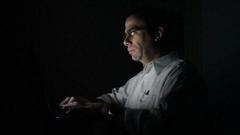
LINKS
THE WARWICK FILES
-
"ACCLAIMED as a 'master raconteur' who writes with a 'flair' (Times Literary Supplement of London), Hoffman authored two non-fiction books and contributed to over a dozen others before writing The Warwick Files.IN ADDITION to writing and traveling the world lecturing about his books, Hoffman has also directed a dance troupe, taught darkroom technique, and explored Patagonia on horseback. He lives just north of New York City.
KEEP UP with all his work on Facebook."
INSTAGRAM
No Instagram images were found.




